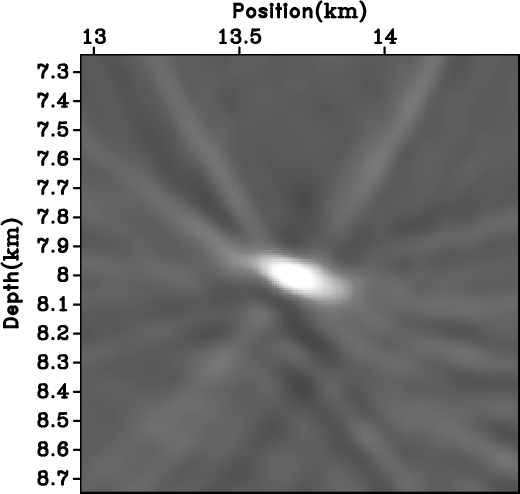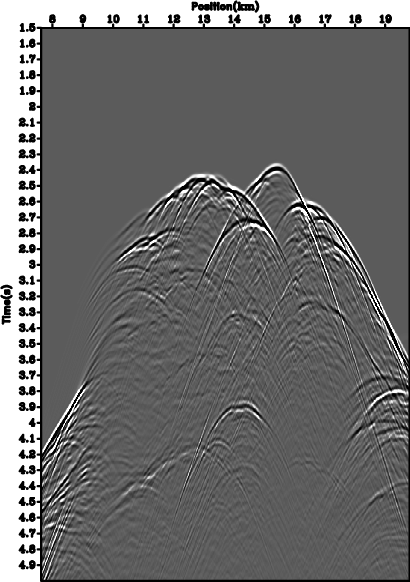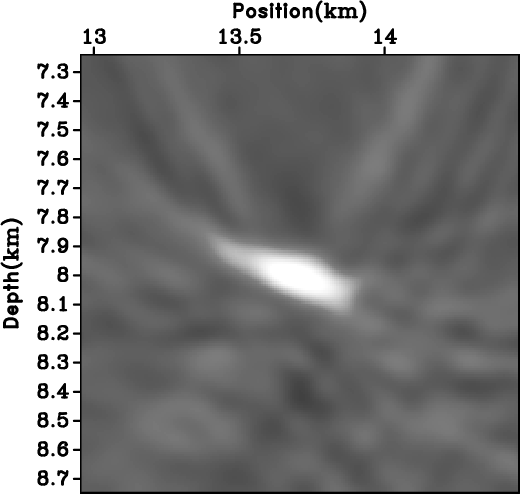|
|
|
|
Interferometric imaging condition for wave-equation migration |
By statistical instability we mean that images obtained for different realizations of random models with the identical statistics are different. Figures 7(a)-7(c) illustrate data modeled for different realizations of the random model in Figure 3(b). The general kinematics of the data are the same, but subtle differences exist between the various datasets due to the random model variations. Migration using a conventional imaging condition leads to the images in Figures 7(d)-7(f) which also show variations from one realization to another. In contrast, Figures 7(g)-7(i) show images obtained by the interferometric imaging condition in equations 5-8, which are more similar to one-another since many of the artifacts have been attenuated.









|
|---|
|
pdv-r0,pdv-r1,pdv-r2,winpcic-r0,winpcic-r1,winpcic-r2,winpiic-r0,winpiic-r1,winpiic-r2
Figure 7. Illustration of statistical stability for the interferometric imaging condition in presence of random model variations. Data modeled using velocity with random variations of magnitude |
|
|
In typical seismic imaging problems, we cannot ensure that random
velocity fluctuations are small (e.g. ![]() ). It is
desirable that imaging remains statistically stable even in cases when
velocity varies with larger magnitude. We investigate the statistical
properties of the imaging functional in equations 5-8 using
numerical experiments similar to the one used earlier. We describe the
random noise present in the velocity models using the following
parameters explained in Appendix A: seismic spatial wavelength
). It is
desirable that imaging remains statistically stable even in cases when
velocity varies with larger magnitude. We investigate the statistical
properties of the imaging functional in equations 5-8 using
numerical experiments similar to the one used earlier. We describe the
random noise present in the velocity models using the following
parameters explained in Appendix A: seismic spatial wavelength
![]() m, wavelet central frequency
m, wavelet central frequency ![]() Hz, random
fluctuations parameters:
Hz, random
fluctuations parameters: ![]() ,
, ![]() ,
, ![]() , and
random noise magnitude
, and
random noise magnitude ![]() between
between ![]() and
and ![]() . This
numerical experiment simulates a situation that mixes the theoretical
regimes explained in Appendix B: random model fluctuations of
comparable scale with the seismic wavelength lead to destruction of
the wavefronts, as suggested by the ``weak fluctuations'' regime;
large magnitude of the random noise leads to diffusion of the
wavefronts, as suggested by the ``diffusion approximation''
regime. This combination of parameters could be regarded as a
worst-case-scenario from a theoretical standpoint.
. This
numerical experiment simulates a situation that mixes the theoretical
regimes explained in Appendix B: random model fluctuations of
comparable scale with the seismic wavelength lead to destruction of
the wavefronts, as suggested by the ``weak fluctuations'' regime;
large magnitude of the random noise leads to diffusion of the
wavefronts, as suggested by the ``diffusion approximation''
regime. This combination of parameters could be regarded as a
worst-case-scenario from a theoretical standpoint.
Figures 8(a)-8(c) show data simulated in models
similar to the one depicted in Figure 3(b), but where the random
noise component is described by
![]() , respectively. As
expected, the wavefronts recorded at the surface are increasingly
distorted to the point where some of the later arrival are not even
visible in the data.
, respectively. As
expected, the wavefronts recorded at the surface are increasingly
distorted to the point where some of the later arrival are not even
visible in the data.
Migration using a conventional imaging condition leads to the images in Figures 8(d)-8(f). As expected, the images show stronger artifacts due to the larger defocusing caused by the unknown random fluctuations in the model. However, migration using the interferometric imaging condition leads to the images in Figures 8(g)-8(i). Artifacts are significantly reduced and the images are much better focused.









|
|---|
|
pdv-m0,pdv-m1,pdv-m2,winpcic-m0,winpcic-m1,winpcic-m2,winpiic-m0,winpiic-m1,winpiic-m2
Figure 8. Illustration of interferometric imaging condition robustness in presence of random model variations. Data modeled using velocity with random variations of magnitudes |
|
|
|
|
|
|
Interferometric imaging condition for wave-equation migration |